Knowledge Management System Proposal for Business Improvement
VerifiedAdded on 2022/08/23
|21
|5530
|25
Report
AI Summary
This report presents a detailed proposal for implementing a Knowledge Management System (KMS) within an organization. It begins with a letter to the Board of Directors, highlighting the need for a KMS to improve business operations and customer service. The report then provides an executive summary outlining the scope, which includes an examination of knowledge management concepts, its lifecycle, internal and external factors, system design, analysis, development, implementation, testing, and post-implementation activities. The report emphasizes the importance of KMS in enhancing organizational competitiveness, innovation, and decision-making. It discusses the roles of tacit and explicit knowledge, and the importance of people in knowledge management. Furthermore, it addresses problems and opportunities related to Information Systems (IS/IT), system design and analysis, development, implementation, testing, and risk management. The report also explores the internal and external factors influencing KMS, including globalization, and the need for effective management tools. Finally, it underscores the significance of KM in generating value from knowledge assets and fostering a culture of knowledge sharing within the organization.
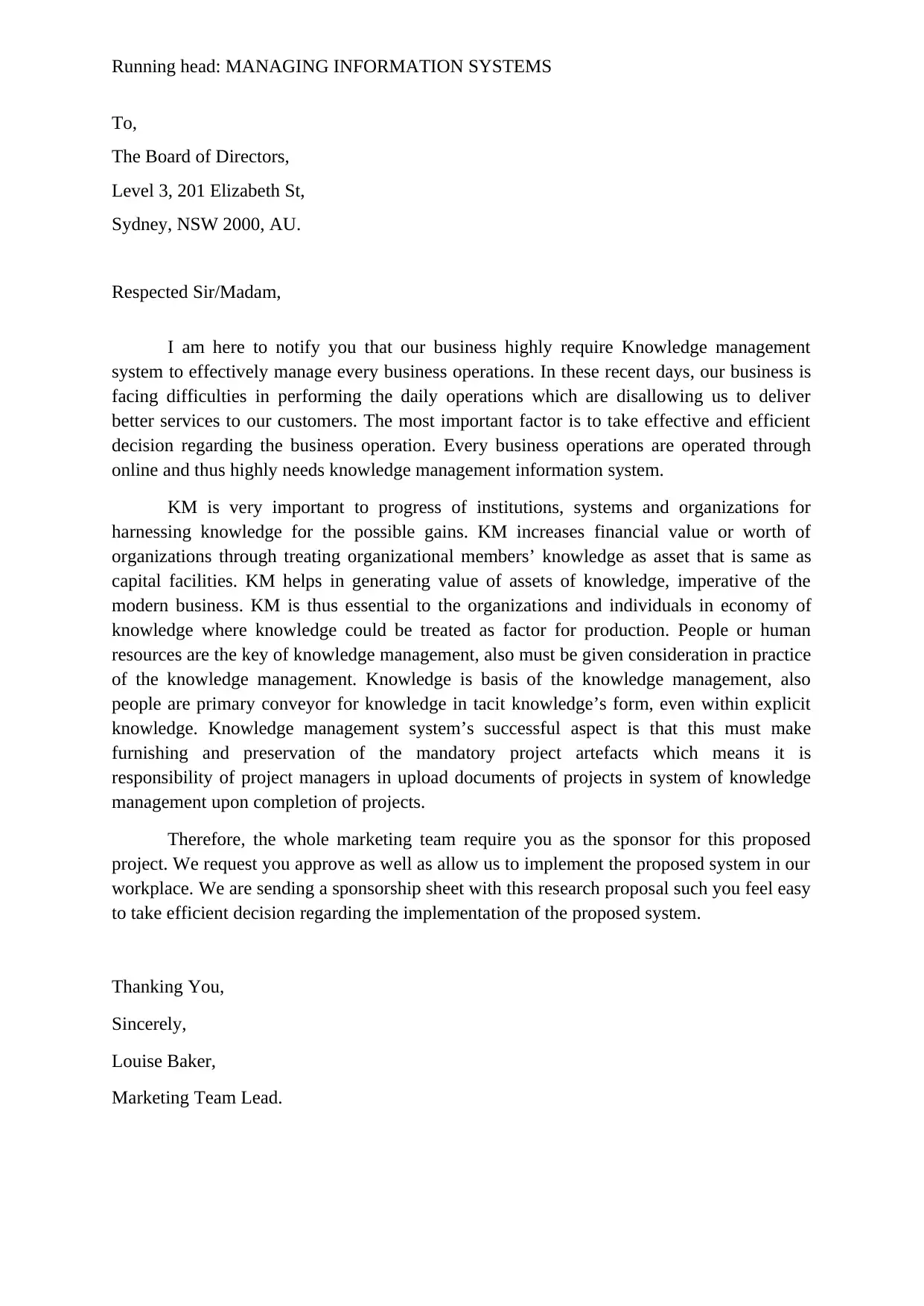
Running head: MANAGING INFORMATION SYSTEMS
To,
The Board of Directors,
Level 3, 201 Elizabeth St,
Sydney, NSW 2000, AU.
Respected Sir/Madam,
I am here to notify you that our business highly require Knowledge management
system to effectively manage every business operations. In these recent days, our business is
facing difficulties in performing the daily operations which are disallowing us to deliver
better services to our customers. The most important factor is to take effective and efficient
decision regarding the business operation. Every business operations are operated through
online and thus highly needs knowledge management information system.
KM is very important to progress of institutions, systems and organizations for
harnessing knowledge for the possible gains. KM increases financial value or worth of
organizations through treating organizational members’ knowledge as asset that is same as
capital facilities. KM helps in generating value of assets of knowledge, imperative of the
modern business. KM is thus essential to the organizations and individuals in economy of
knowledge where knowledge could be treated as factor for production. People or human
resources are the key of knowledge management, also must be given consideration in practice
of the knowledge management. Knowledge is basis of the knowledge management, also
people are primary conveyor for knowledge in tacit knowledge’s form, even within explicit
knowledge. Knowledge management system’s successful aspect is that this must make
furnishing and preservation of the mandatory project artefacts which means it is
responsibility of project managers in upload documents of projects in system of knowledge
management upon completion of projects.
Therefore, the whole marketing team require you as the sponsor for this proposed
project. We request you approve as well as allow us to implement the proposed system in our
workplace. We are sending a sponsorship sheet with this research proposal such you feel easy
to take efficient decision regarding the implementation of the proposed system.
Thanking You,
Sincerely,
Louise Baker,
Marketing Team Lead.
To,
The Board of Directors,
Level 3, 201 Elizabeth St,
Sydney, NSW 2000, AU.
Respected Sir/Madam,
I am here to notify you that our business highly require Knowledge management
system to effectively manage every business operations. In these recent days, our business is
facing difficulties in performing the daily operations which are disallowing us to deliver
better services to our customers. The most important factor is to take effective and efficient
decision regarding the business operation. Every business operations are operated through
online and thus highly needs knowledge management information system.
KM is very important to progress of institutions, systems and organizations for
harnessing knowledge for the possible gains. KM increases financial value or worth of
organizations through treating organizational members’ knowledge as asset that is same as
capital facilities. KM helps in generating value of assets of knowledge, imperative of the
modern business. KM is thus essential to the organizations and individuals in economy of
knowledge where knowledge could be treated as factor for production. People or human
resources are the key of knowledge management, also must be given consideration in practice
of the knowledge management. Knowledge is basis of the knowledge management, also
people are primary conveyor for knowledge in tacit knowledge’s form, even within explicit
knowledge. Knowledge management system’s successful aspect is that this must make
furnishing and preservation of the mandatory project artefacts which means it is
responsibility of project managers in upload documents of projects in system of knowledge
management upon completion of projects.
Therefore, the whole marketing team require you as the sponsor for this proposed
project. We request you approve as well as allow us to implement the proposed system in our
workplace. We are sending a sponsorship sheet with this research proposal such you feel easy
to take efficient decision regarding the implementation of the proposed system.
Thanking You,
Sincerely,
Louise Baker,
Marketing Team Lead.
Paraphrase This Document
Need a fresh take? Get an instant paraphrase of this document with our AI Paraphraser

1MANAGING INFORMATION SYSTEMS
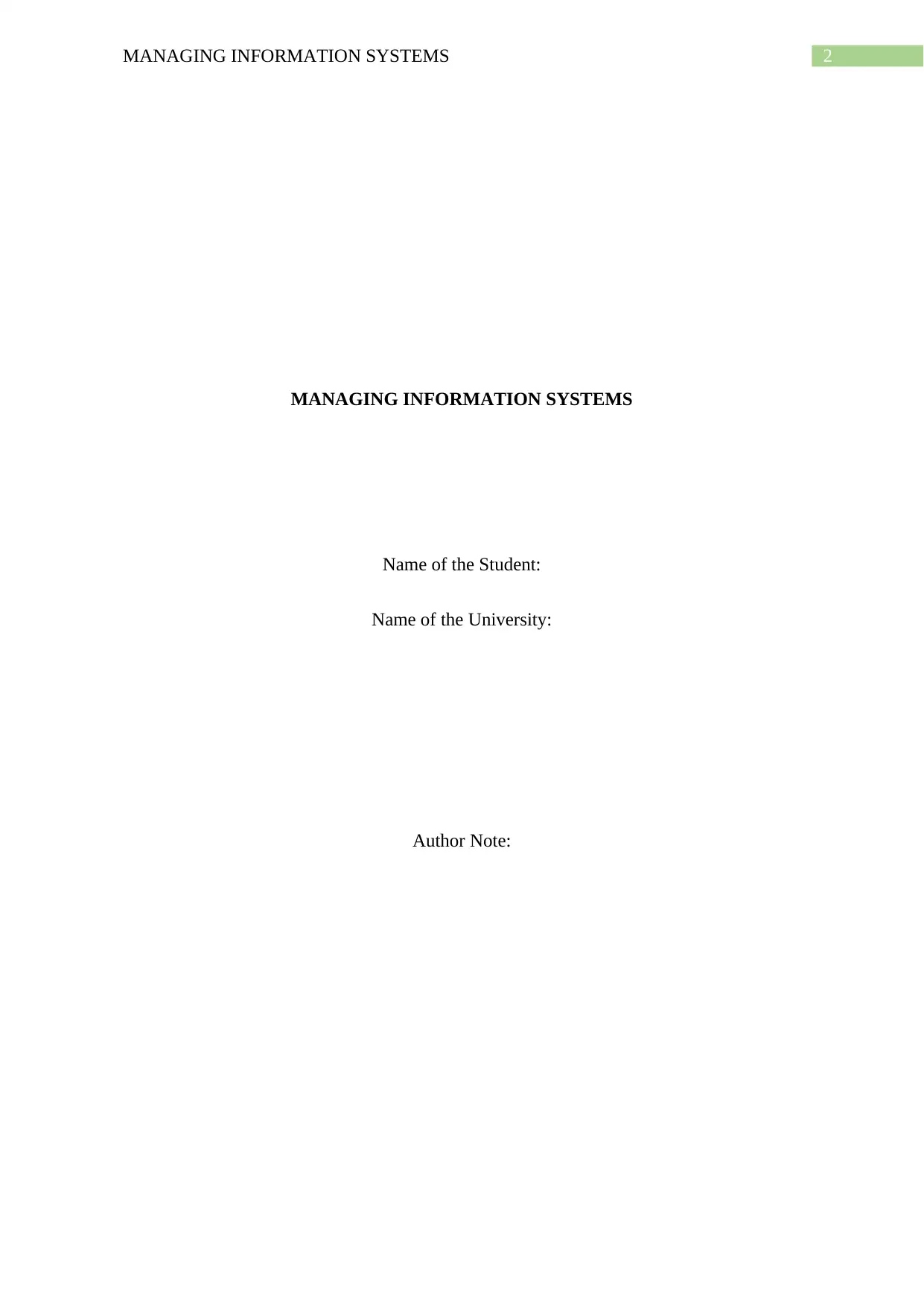
2MANAGING INFORMATION SYSTEMS
MANAGING INFORMATION SYSTEMS
Name of the Student:
Name of the University:
Author Note:
MANAGING INFORMATION SYSTEMS
Name of the Student:
Name of the University:
Author Note:
⊘ This is a preview!⊘
Do you want full access?
Subscribe today to unlock all pages.

Trusted by 1+ million students worldwide
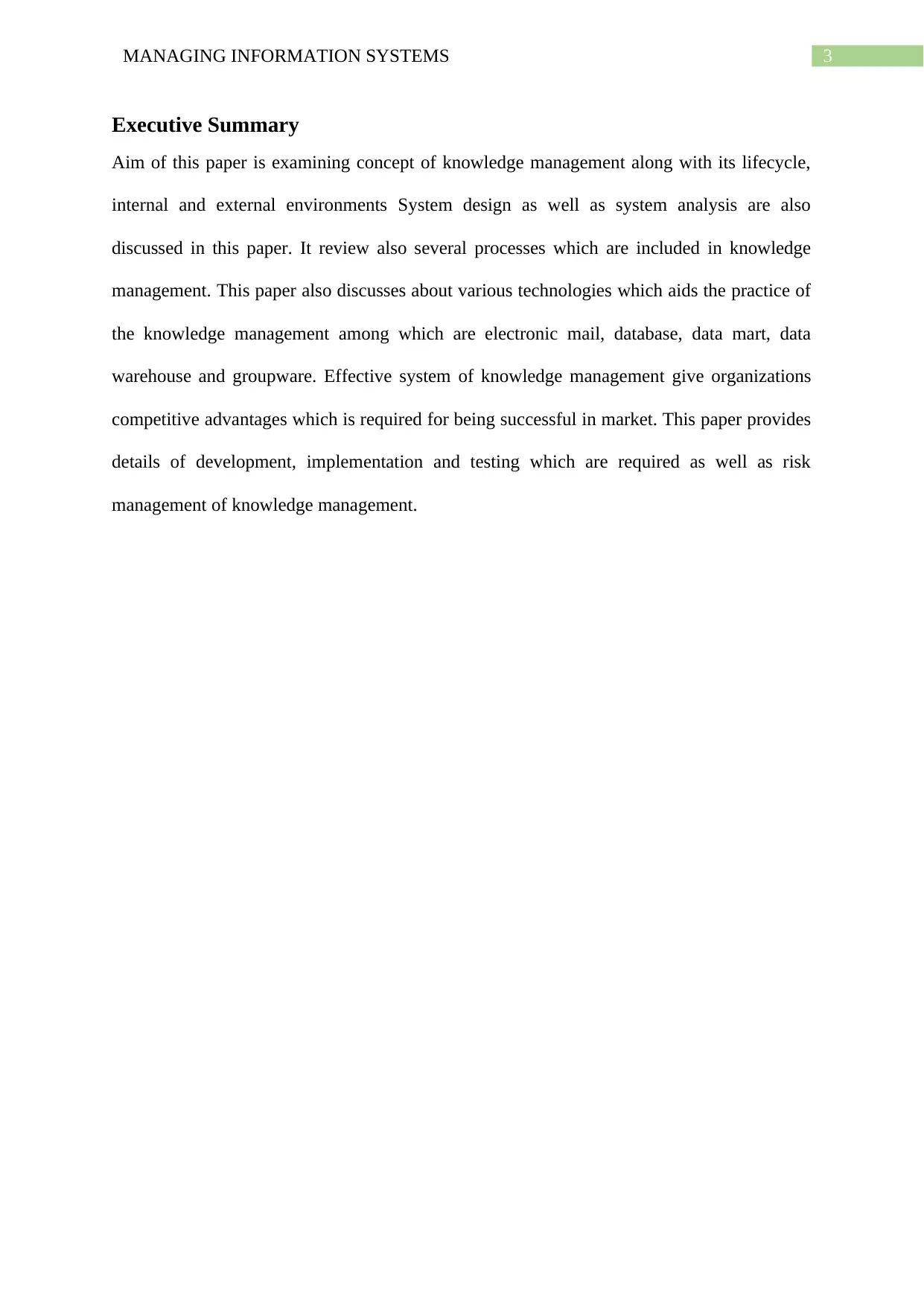
3MANAGING INFORMATION SYSTEMS
Executive Summary
Aim of this paper is examining concept of knowledge management along with its lifecycle,
internal and external environments System design as well as system analysis are also
discussed in this paper. It review also several processes which are included in knowledge
management. This paper also discusses about various technologies which aids the practice of
the knowledge management among which are electronic mail, database, data mart, data
warehouse and groupware. Effective system of knowledge management give organizations
competitive advantages which is required for being successful in market. This paper provides
details of development, implementation and testing which are required as well as risk
management of knowledge management.
Executive Summary
Aim of this paper is examining concept of knowledge management along with its lifecycle,
internal and external environments System design as well as system analysis are also
discussed in this paper. It review also several processes which are included in knowledge
management. This paper also discusses about various technologies which aids the practice of
the knowledge management among which are electronic mail, database, data mart, data
warehouse and groupware. Effective system of knowledge management give organizations
competitive advantages which is required for being successful in market. This paper provides
details of development, implementation and testing which are required as well as risk
management of knowledge management.
Paraphrase This Document
Need a fresh take? Get an instant paraphrase of this document with our AI Paraphraser
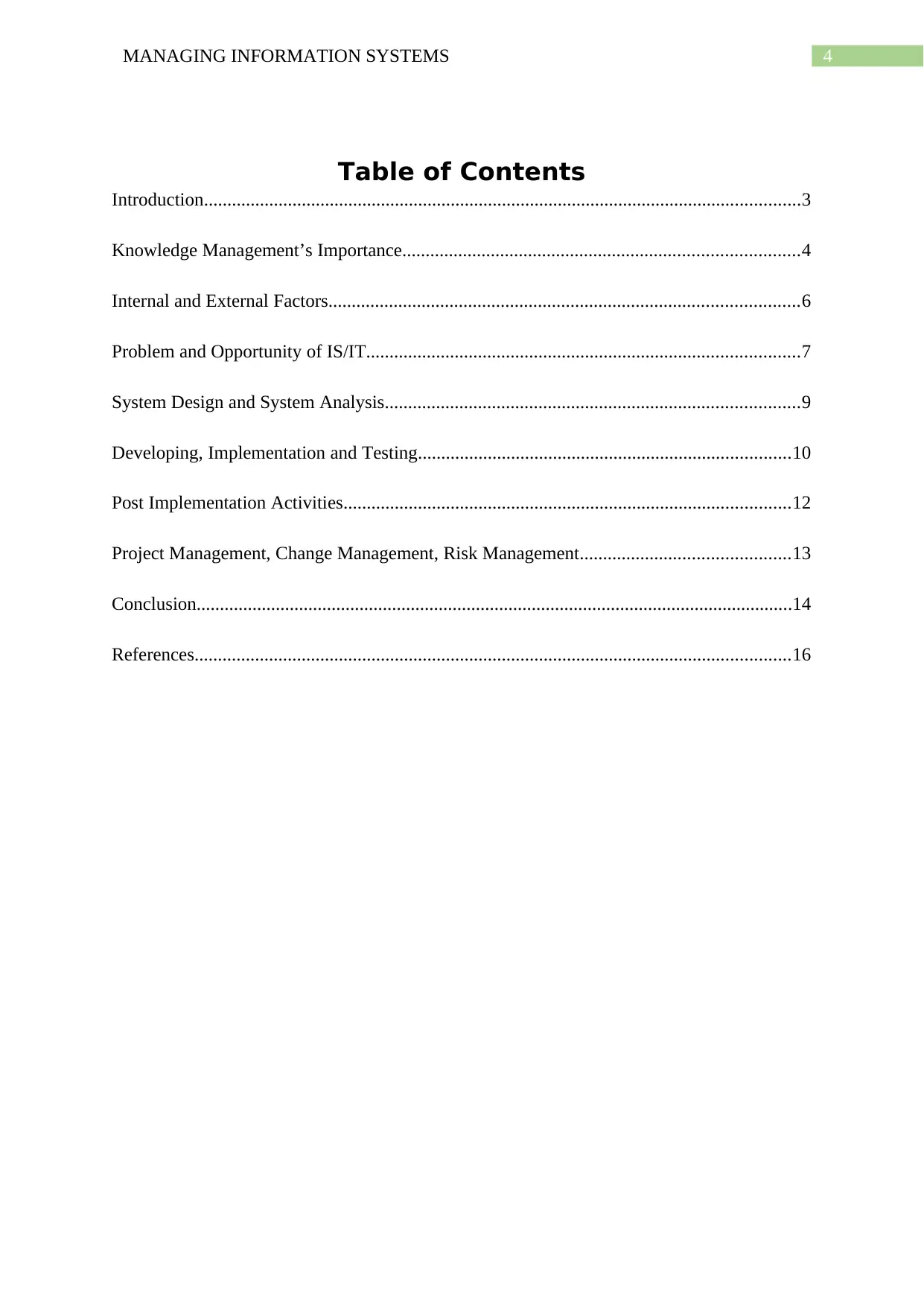
4MANAGING INFORMATION SYSTEMS
Table of Contents
Introduction................................................................................................................................3
Knowledge Management’s Importance.....................................................................................4
Internal and External Factors.....................................................................................................6
Problem and Opportunity of IS/IT.............................................................................................7
System Design and System Analysis.........................................................................................9
Developing, Implementation and Testing................................................................................10
Post Implementation Activities................................................................................................12
Project Management, Change Management, Risk Management.............................................13
Conclusion................................................................................................................................14
References................................................................................................................................16
Table of Contents
Introduction................................................................................................................................3
Knowledge Management’s Importance.....................................................................................4
Internal and External Factors.....................................................................................................6
Problem and Opportunity of IS/IT.............................................................................................7
System Design and System Analysis.........................................................................................9
Developing, Implementation and Testing................................................................................10
Post Implementation Activities................................................................................................12
Project Management, Change Management, Risk Management.............................................13
Conclusion................................................................................................................................14
References................................................................................................................................16
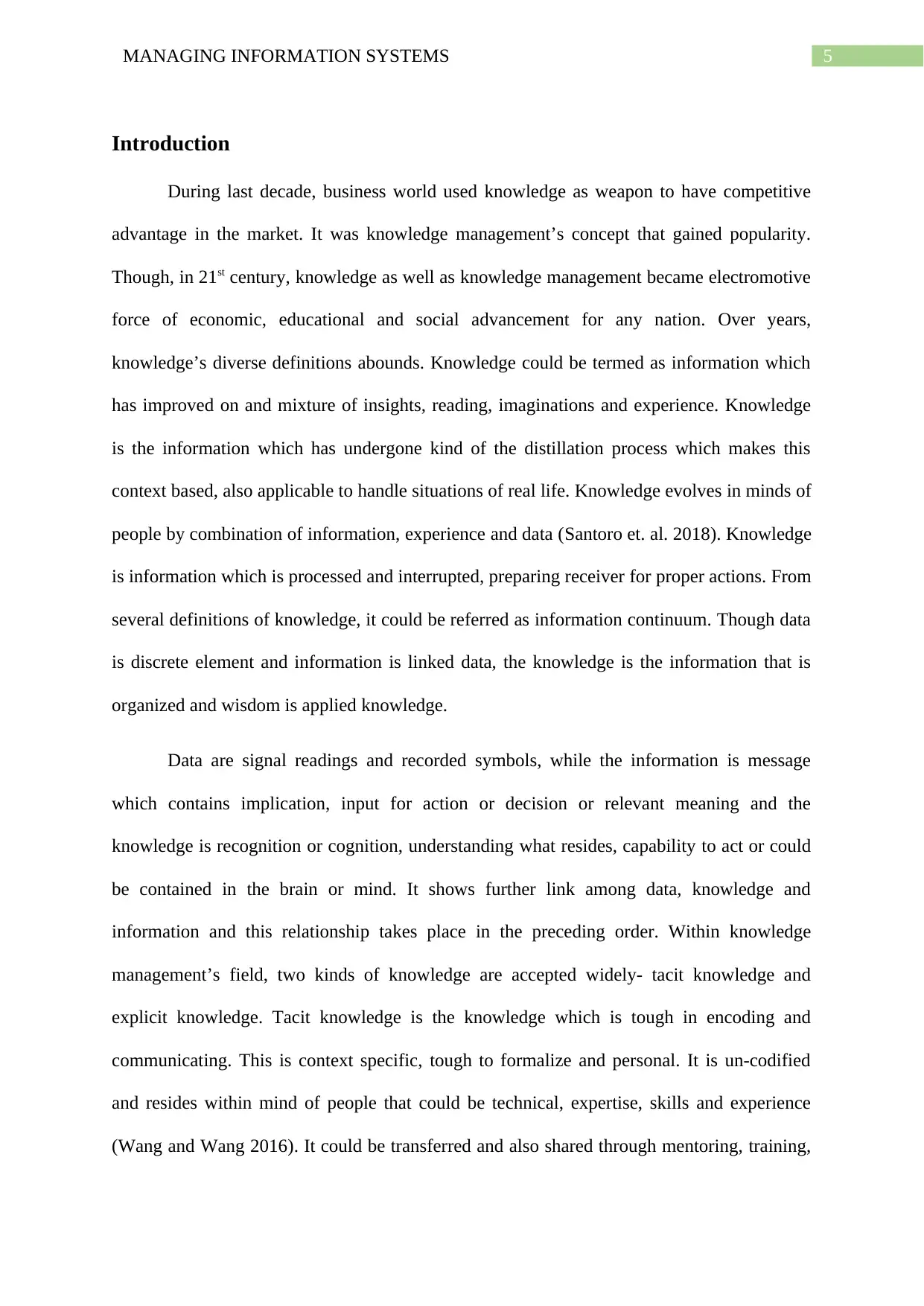
5MANAGING INFORMATION SYSTEMS
Introduction
During last decade, business world used knowledge as weapon to have competitive
advantage in the market. It was knowledge management’s concept that gained popularity.
Though, in 21st century, knowledge as well as knowledge management became electromotive
force of economic, educational and social advancement for any nation. Over years,
knowledge’s diverse definitions abounds. Knowledge could be termed as information which
has improved on and mixture of insights, reading, imaginations and experience. Knowledge
is the information which has undergone kind of the distillation process which makes this
context based, also applicable to handle situations of real life. Knowledge evolves in minds of
people by combination of information, experience and data (Santoro et. al. 2018). Knowledge
is information which is processed and interrupted, preparing receiver for proper actions. From
several definitions of knowledge, it could be referred as information continuum. Though data
is discrete element and information is linked data, the knowledge is the information that is
organized and wisdom is applied knowledge.
Data are signal readings and recorded symbols, while the information is message
which contains implication, input for action or decision or relevant meaning and the
knowledge is recognition or cognition, understanding what resides, capability to act or could
be contained in the brain or mind. It shows further link among data, knowledge and
information and this relationship takes place in the preceding order. Within knowledge
management’s field, two kinds of knowledge are accepted widely- tacit knowledge and
explicit knowledge. Tacit knowledge is the knowledge which is tough in encoding and
communicating. This is context specific, tough to formalize and personal. It is un-codified
and resides within mind of people that could be technical, expertise, skills and experience
(Wang and Wang 2016). It could be transferred and also shared through mentoring, training,
Introduction
During last decade, business world used knowledge as weapon to have competitive
advantage in the market. It was knowledge management’s concept that gained popularity.
Though, in 21st century, knowledge as well as knowledge management became electromotive
force of economic, educational and social advancement for any nation. Over years,
knowledge’s diverse definitions abounds. Knowledge could be termed as information which
has improved on and mixture of insights, reading, imaginations and experience. Knowledge
is the information which has undergone kind of the distillation process which makes this
context based, also applicable to handle situations of real life. Knowledge evolves in minds of
people by combination of information, experience and data (Santoro et. al. 2018). Knowledge
is information which is processed and interrupted, preparing receiver for proper actions. From
several definitions of knowledge, it could be referred as information continuum. Though data
is discrete element and information is linked data, the knowledge is the information that is
organized and wisdom is applied knowledge.
Data are signal readings and recorded symbols, while the information is message
which contains implication, input for action or decision or relevant meaning and the
knowledge is recognition or cognition, understanding what resides, capability to act or could
be contained in the brain or mind. It shows further link among data, knowledge and
information and this relationship takes place in the preceding order. Within knowledge
management’s field, two kinds of knowledge are accepted widely- tacit knowledge and
explicit knowledge. Tacit knowledge is the knowledge which is tough in encoding and
communicating. This is context specific, tough to formalize and personal. It is un-codified
and resides within mind of people that could be technical, expertise, skills and experience
(Wang and Wang 2016). It could be transferred and also shared through mentoring, training,
⊘ This is a preview!⊘
Do you want full access?
Subscribe today to unlock all pages.

Trusted by 1+ million students worldwide
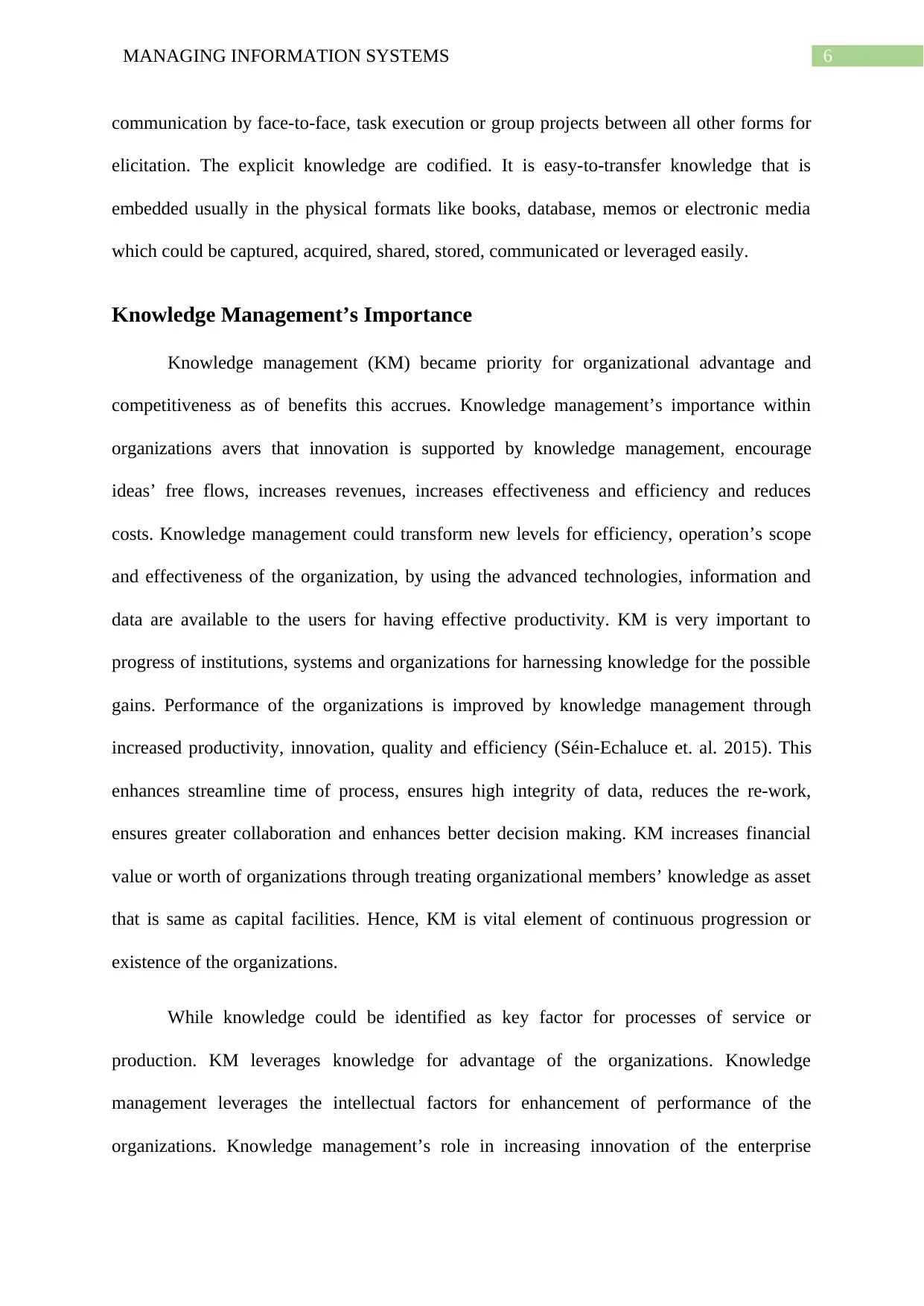
6MANAGING INFORMATION SYSTEMS
communication by face-to-face, task execution or group projects between all other forms for
elicitation. The explicit knowledge are codified. It is easy-to-transfer knowledge that is
embedded usually in the physical formats like books, database, memos or electronic media
which could be captured, acquired, shared, stored, communicated or leveraged easily.
Knowledge Management’s Importance
Knowledge management (KM) became priority for organizational advantage and
competitiveness as of benefits this accrues. Knowledge management’s importance within
organizations avers that innovation is supported by knowledge management, encourage
ideas’ free flows, increases revenues, increases effectiveness and efficiency and reduces
costs. Knowledge management could transform new levels for efficiency, operation’s scope
and effectiveness of the organization, by using the advanced technologies, information and
data are available to the users for having effective productivity. KM is very important to
progress of institutions, systems and organizations for harnessing knowledge for the possible
gains. Performance of the organizations is improved by knowledge management through
increased productivity, innovation, quality and efficiency (Séin-Echaluce et. al. 2015). This
enhances streamline time of process, ensures high integrity of data, reduces the re-work,
ensures greater collaboration and enhances better decision making. KM increases financial
value or worth of organizations through treating organizational members’ knowledge as asset
that is same as capital facilities. Hence, KM is vital element of continuous progression or
existence of the organizations.
While knowledge could be identified as key factor for processes of service or
production. KM leverages knowledge for advantage of the organizations. Knowledge
management leverages the intellectual factors for enhancement of performance of the
organizations. Knowledge management’s role in increasing innovation of the enterprise
communication by face-to-face, task execution or group projects between all other forms for
elicitation. The explicit knowledge are codified. It is easy-to-transfer knowledge that is
embedded usually in the physical formats like books, database, memos or electronic media
which could be captured, acquired, shared, stored, communicated or leveraged easily.
Knowledge Management’s Importance
Knowledge management (KM) became priority for organizational advantage and
competitiveness as of benefits this accrues. Knowledge management’s importance within
organizations avers that innovation is supported by knowledge management, encourage
ideas’ free flows, increases revenues, increases effectiveness and efficiency and reduces
costs. Knowledge management could transform new levels for efficiency, operation’s scope
and effectiveness of the organization, by using the advanced technologies, information and
data are available to the users for having effective productivity. KM is very important to
progress of institutions, systems and organizations for harnessing knowledge for the possible
gains. Performance of the organizations is improved by knowledge management through
increased productivity, innovation, quality and efficiency (Séin-Echaluce et. al. 2015). This
enhances streamline time of process, ensures high integrity of data, reduces the re-work,
ensures greater collaboration and enhances better decision making. KM increases financial
value or worth of organizations through treating organizational members’ knowledge as asset
that is same as capital facilities. Hence, KM is vital element of continuous progression or
existence of the organizations.
While knowledge could be identified as key factor for processes of service or
production. KM leverages knowledge for advantage of the organizations. Knowledge
management leverages the intellectual factors for enhancement of performance of the
organizations. Knowledge management’s role in increasing innovation of the enterprise
Paraphrase This Document
Need a fresh take? Get an instant paraphrase of this document with our AI Paraphraser
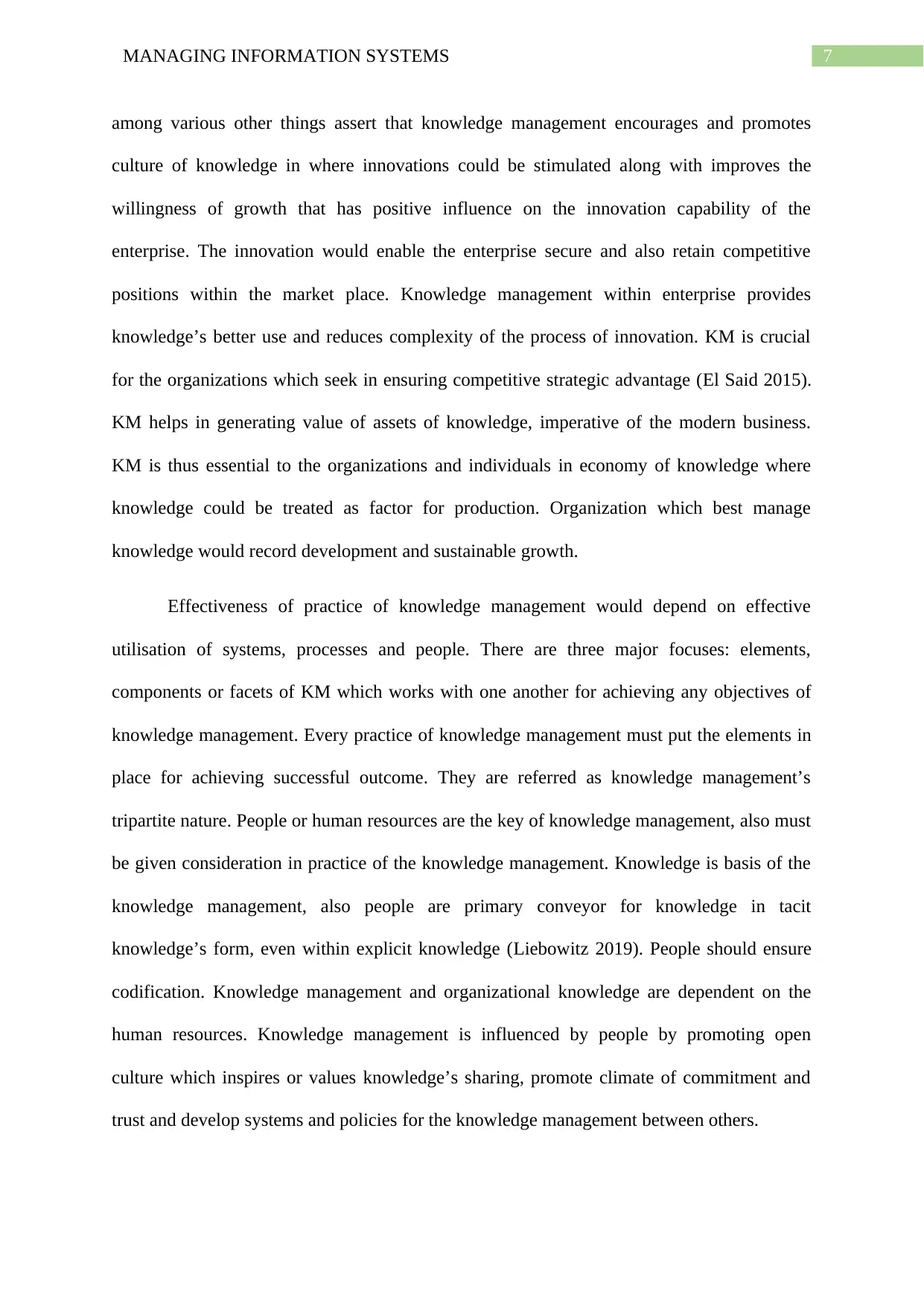
7MANAGING INFORMATION SYSTEMS
among various other things assert that knowledge management encourages and promotes
culture of knowledge in where innovations could be stimulated along with improves the
willingness of growth that has positive influence on the innovation capability of the
enterprise. The innovation would enable the enterprise secure and also retain competitive
positions within the market place. Knowledge management within enterprise provides
knowledge’s better use and reduces complexity of the process of innovation. KM is crucial
for the organizations which seek in ensuring competitive strategic advantage (El Said 2015).
KM helps in generating value of assets of knowledge, imperative of the modern business.
KM is thus essential to the organizations and individuals in economy of knowledge where
knowledge could be treated as factor for production. Organization which best manage
knowledge would record development and sustainable growth.
Effectiveness of practice of knowledge management would depend on effective
utilisation of systems, processes and people. There are three major focuses: elements,
components or facets of KM which works with one another for achieving any objectives of
knowledge management. Every practice of knowledge management must put the elements in
place for achieving successful outcome. They are referred as knowledge management’s
tripartite nature. People or human resources are the key of knowledge management, also must
be given consideration in practice of the knowledge management. Knowledge is basis of the
knowledge management, also people are primary conveyor for knowledge in tacit
knowledge’s form, even within explicit knowledge (Liebowitz 2019). People should ensure
codification. Knowledge management and organizational knowledge are dependent on the
human resources. Knowledge management is influenced by people by promoting open
culture which inspires or values knowledge’s sharing, promote climate of commitment and
trust and develop systems and policies for the knowledge management between others.
among various other things assert that knowledge management encourages and promotes
culture of knowledge in where innovations could be stimulated along with improves the
willingness of growth that has positive influence on the innovation capability of the
enterprise. The innovation would enable the enterprise secure and also retain competitive
positions within the market place. Knowledge management within enterprise provides
knowledge’s better use and reduces complexity of the process of innovation. KM is crucial
for the organizations which seek in ensuring competitive strategic advantage (El Said 2015).
KM helps in generating value of assets of knowledge, imperative of the modern business.
KM is thus essential to the organizations and individuals in economy of knowledge where
knowledge could be treated as factor for production. Organization which best manage
knowledge would record development and sustainable growth.
Effectiveness of practice of knowledge management would depend on effective
utilisation of systems, processes and people. There are three major focuses: elements,
components or facets of KM which works with one another for achieving any objectives of
knowledge management. Every practice of knowledge management must put the elements in
place for achieving successful outcome. They are referred as knowledge management’s
tripartite nature. People or human resources are the key of knowledge management, also must
be given consideration in practice of the knowledge management. Knowledge is basis of the
knowledge management, also people are primary conveyor for knowledge in tacit
knowledge’s form, even within explicit knowledge (Liebowitz 2019). People should ensure
codification. Knowledge management and organizational knowledge are dependent on the
human resources. Knowledge management is influenced by people by promoting open
culture which inspires or values knowledge’s sharing, promote climate of commitment and
trust and develop systems and policies for the knowledge management between others.
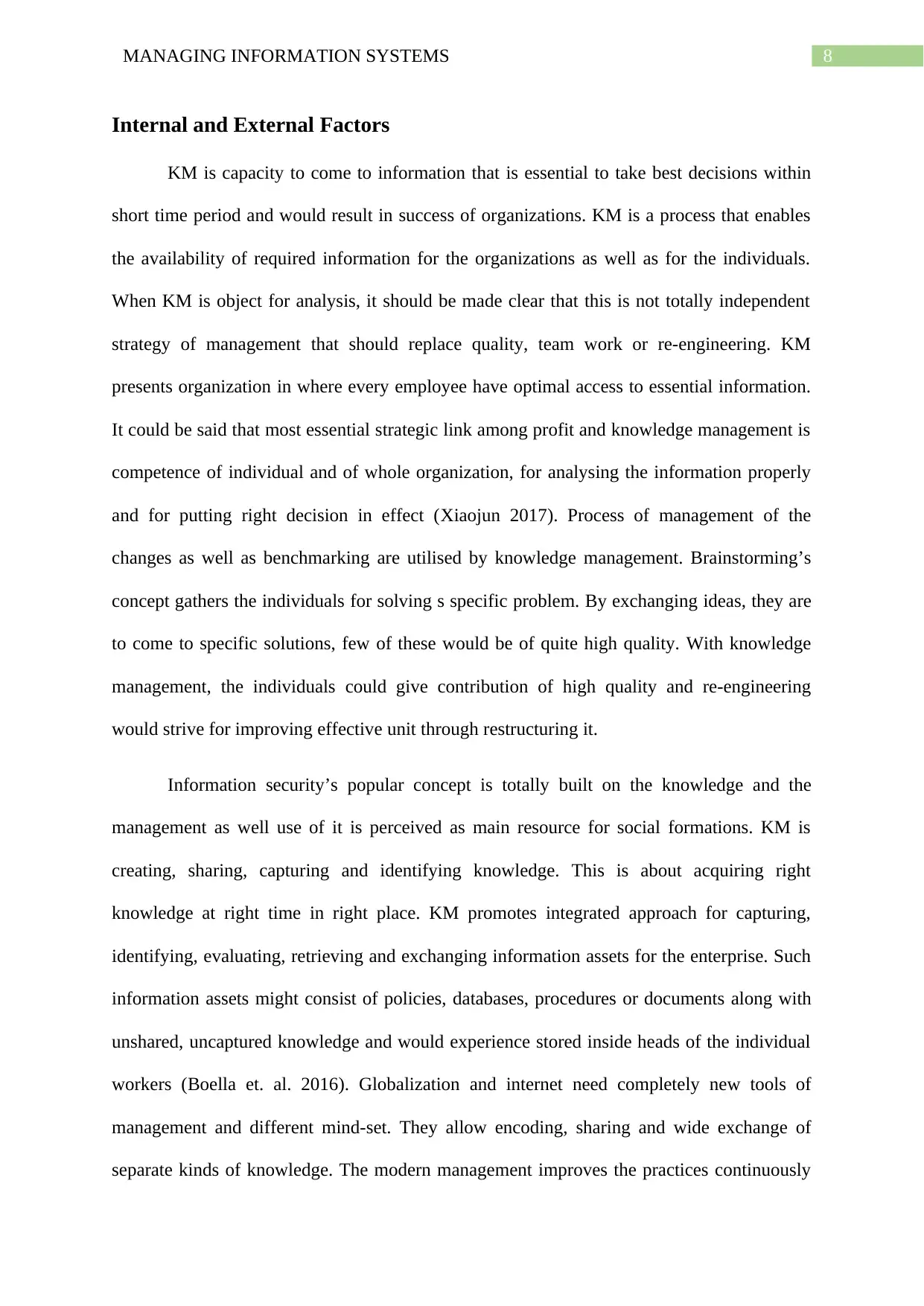
8MANAGING INFORMATION SYSTEMS
Internal and External Factors
KM is capacity to come to information that is essential to take best decisions within
short time period and would result in success of organizations. KM is a process that enables
the availability of required information for the organizations as well as for the individuals.
When KM is object for analysis, it should be made clear that this is not totally independent
strategy of management that should replace quality, team work or re-engineering. KM
presents organization in where every employee have optimal access to essential information.
It could be said that most essential strategic link among profit and knowledge management is
competence of individual and of whole organization, for analysing the information properly
and for putting right decision in effect (Xiaojun 2017). Process of management of the
changes as well as benchmarking are utilised by knowledge management. Brainstorming’s
concept gathers the individuals for solving s specific problem. By exchanging ideas, they are
to come to specific solutions, few of these would be of quite high quality. With knowledge
management, the individuals could give contribution of high quality and re-engineering
would strive for improving effective unit through restructuring it.
Information security’s popular concept is totally built on the knowledge and the
management as well use of it is perceived as main resource for social formations. KM is
creating, sharing, capturing and identifying knowledge. This is about acquiring right
knowledge at right time in right place. KM promotes integrated approach for capturing,
identifying, evaluating, retrieving and exchanging information assets for the enterprise. Such
information assets might consist of policies, databases, procedures or documents along with
unshared, uncaptured knowledge and would experience stored inside heads of the individual
workers (Boella et. al. 2016). Globalization and internet need completely new tools of
management and different mind-set. They allow encoding, sharing and wide exchange of
separate kinds of knowledge. The modern management improves the practices continuously
Internal and External Factors
KM is capacity to come to information that is essential to take best decisions within
short time period and would result in success of organizations. KM is a process that enables
the availability of required information for the organizations as well as for the individuals.
When KM is object for analysis, it should be made clear that this is not totally independent
strategy of management that should replace quality, team work or re-engineering. KM
presents organization in where every employee have optimal access to essential information.
It could be said that most essential strategic link among profit and knowledge management is
competence of individual and of whole organization, for analysing the information properly
and for putting right decision in effect (Xiaojun 2017). Process of management of the
changes as well as benchmarking are utilised by knowledge management. Brainstorming’s
concept gathers the individuals for solving s specific problem. By exchanging ideas, they are
to come to specific solutions, few of these would be of quite high quality. With knowledge
management, the individuals could give contribution of high quality and re-engineering
would strive for improving effective unit through restructuring it.
Information security’s popular concept is totally built on the knowledge and the
management as well use of it is perceived as main resource for social formations. KM is
creating, sharing, capturing and identifying knowledge. This is about acquiring right
knowledge at right time in right place. KM promotes integrated approach for capturing,
identifying, evaluating, retrieving and exchanging information assets for the enterprise. Such
information assets might consist of policies, databases, procedures or documents along with
unshared, uncaptured knowledge and would experience stored inside heads of the individual
workers (Boella et. al. 2016). Globalization and internet need completely new tools of
management and different mind-set. They allow encoding, sharing and wide exchange of
separate kinds of knowledge. The modern management improves the practices continuously
⊘ This is a preview!⊘
Do you want full access?
Subscribe today to unlock all pages.

Trusted by 1+ million students worldwide
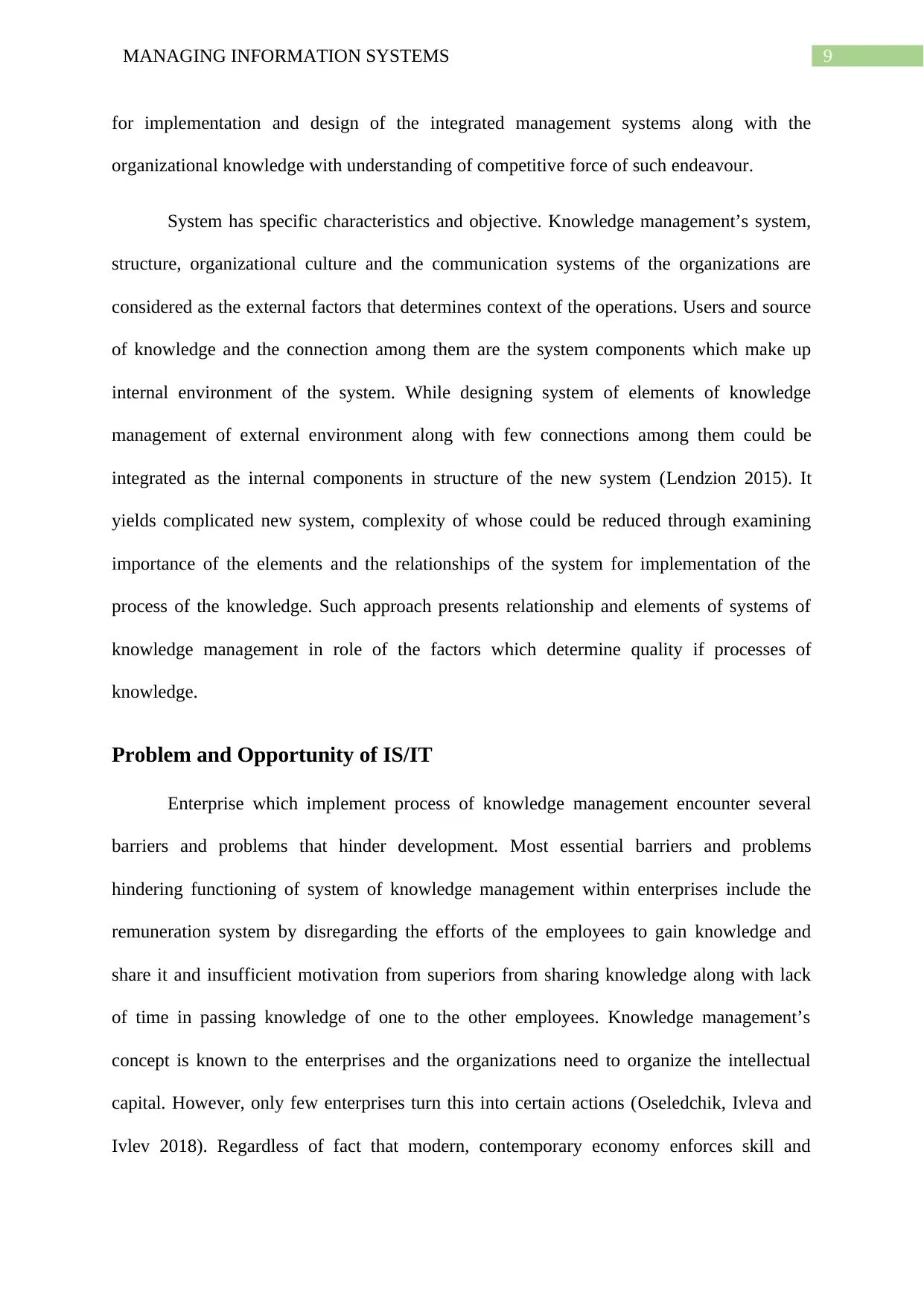
9MANAGING INFORMATION SYSTEMS
for implementation and design of the integrated management systems along with the
organizational knowledge with understanding of competitive force of such endeavour.
System has specific characteristics and objective. Knowledge management’s system,
structure, organizational culture and the communication systems of the organizations are
considered as the external factors that determines context of the operations. Users and source
of knowledge and the connection among them are the system components which make up
internal environment of the system. While designing system of elements of knowledge
management of external environment along with few connections among them could be
integrated as the internal components in structure of the new system (Lendzion 2015). It
yields complicated new system, complexity of whose could be reduced through examining
importance of the elements and the relationships of the system for implementation of the
process of the knowledge. Such approach presents relationship and elements of systems of
knowledge management in role of the factors which determine quality if processes of
knowledge.
Problem and Opportunity of IS/IT
Enterprise which implement process of knowledge management encounter several
barriers and problems that hinder development. Most essential barriers and problems
hindering functioning of system of knowledge management within enterprises include the
remuneration system by disregarding the efforts of the employees to gain knowledge and
share it and insufficient motivation from superiors from sharing knowledge along with lack
of time in passing knowledge of one to the other employees. Knowledge management’s
concept is known to the enterprises and the organizations need to organize the intellectual
capital. However, only few enterprises turn this into certain actions (Oseledchik, Ivleva and
Ivlev 2018). Regardless of fact that modern, contemporary economy enforces skill and
for implementation and design of the integrated management systems along with the
organizational knowledge with understanding of competitive force of such endeavour.
System has specific characteristics and objective. Knowledge management’s system,
structure, organizational culture and the communication systems of the organizations are
considered as the external factors that determines context of the operations. Users and source
of knowledge and the connection among them are the system components which make up
internal environment of the system. While designing system of elements of knowledge
management of external environment along with few connections among them could be
integrated as the internal components in structure of the new system (Lendzion 2015). It
yields complicated new system, complexity of whose could be reduced through examining
importance of the elements and the relationships of the system for implementation of the
process of the knowledge. Such approach presents relationship and elements of systems of
knowledge management in role of the factors which determine quality if processes of
knowledge.
Problem and Opportunity of IS/IT
Enterprise which implement process of knowledge management encounter several
barriers and problems that hinder development. Most essential barriers and problems
hindering functioning of system of knowledge management within enterprises include the
remuneration system by disregarding the efforts of the employees to gain knowledge and
share it and insufficient motivation from superiors from sharing knowledge along with lack
of time in passing knowledge of one to the other employees. Knowledge management’s
concept is known to the enterprises and the organizations need to organize the intellectual
capital. However, only few enterprises turn this into certain actions (Oseledchik, Ivleva and
Ivlev 2018). Regardless of fact that modern, contemporary economy enforces skill and
Paraphrase This Document
Need a fresh take? Get an instant paraphrase of this document with our AI Paraphraser
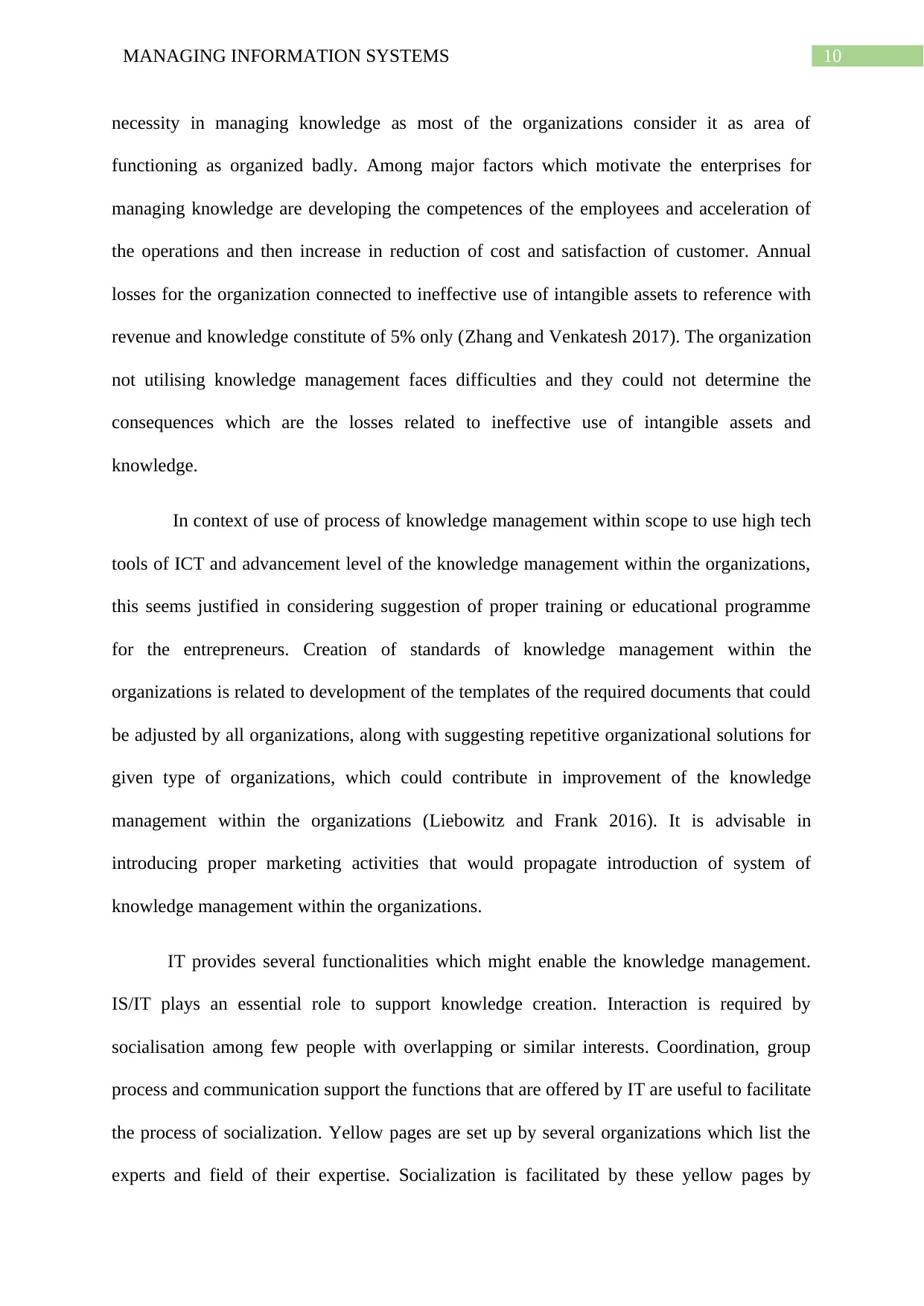
10MANAGING INFORMATION SYSTEMS
necessity in managing knowledge as most of the organizations consider it as area of
functioning as organized badly. Among major factors which motivate the enterprises for
managing knowledge are developing the competences of the employees and acceleration of
the operations and then increase in reduction of cost and satisfaction of customer. Annual
losses for the organization connected to ineffective use of intangible assets to reference with
revenue and knowledge constitute of 5% only (Zhang and Venkatesh 2017). The organization
not utilising knowledge management faces difficulties and they could not determine the
consequences which are the losses related to ineffective use of intangible assets and
knowledge.
In context of use of process of knowledge management within scope to use high tech
tools of ICT and advancement level of the knowledge management within the organizations,
this seems justified in considering suggestion of proper training or educational programme
for the entrepreneurs. Creation of standards of knowledge management within the
organizations is related to development of the templates of the required documents that could
be adjusted by all organizations, along with suggesting repetitive organizational solutions for
given type of organizations, which could contribute in improvement of the knowledge
management within the organizations (Liebowitz and Frank 2016). It is advisable in
introducing proper marketing activities that would propagate introduction of system of
knowledge management within the organizations.
IT provides several functionalities which might enable the knowledge management.
IS/IT plays an essential role to support knowledge creation. Interaction is required by
socialisation among few people with overlapping or similar interests. Coordination, group
process and communication support the functions that are offered by IT are useful to facilitate
the process of socialization. Yellow pages are set up by several organizations which list the
experts and field of their expertise. Socialization is facilitated by these yellow pages by
necessity in managing knowledge as most of the organizations consider it as area of
functioning as organized badly. Among major factors which motivate the enterprises for
managing knowledge are developing the competences of the employees and acceleration of
the operations and then increase in reduction of cost and satisfaction of customer. Annual
losses for the organization connected to ineffective use of intangible assets to reference with
revenue and knowledge constitute of 5% only (Zhang and Venkatesh 2017). The organization
not utilising knowledge management faces difficulties and they could not determine the
consequences which are the losses related to ineffective use of intangible assets and
knowledge.
In context of use of process of knowledge management within scope to use high tech
tools of ICT and advancement level of the knowledge management within the organizations,
this seems justified in considering suggestion of proper training or educational programme
for the entrepreneurs. Creation of standards of knowledge management within the
organizations is related to development of the templates of the required documents that could
be adjusted by all organizations, along with suggesting repetitive organizational solutions for
given type of organizations, which could contribute in improvement of the knowledge
management within the organizations (Liebowitz and Frank 2016). It is advisable in
introducing proper marketing activities that would propagate introduction of system of
knowledge management within the organizations.
IT provides several functionalities which might enable the knowledge management.
IS/IT plays an essential role to support knowledge creation. Interaction is required by
socialisation among few people with overlapping or similar interests. Coordination, group
process and communication support the functions that are offered by IT are useful to facilitate
the process of socialization. Yellow pages are set up by several organizations which list the
experts and field of their expertise. Socialization is facilitated by these yellow pages by
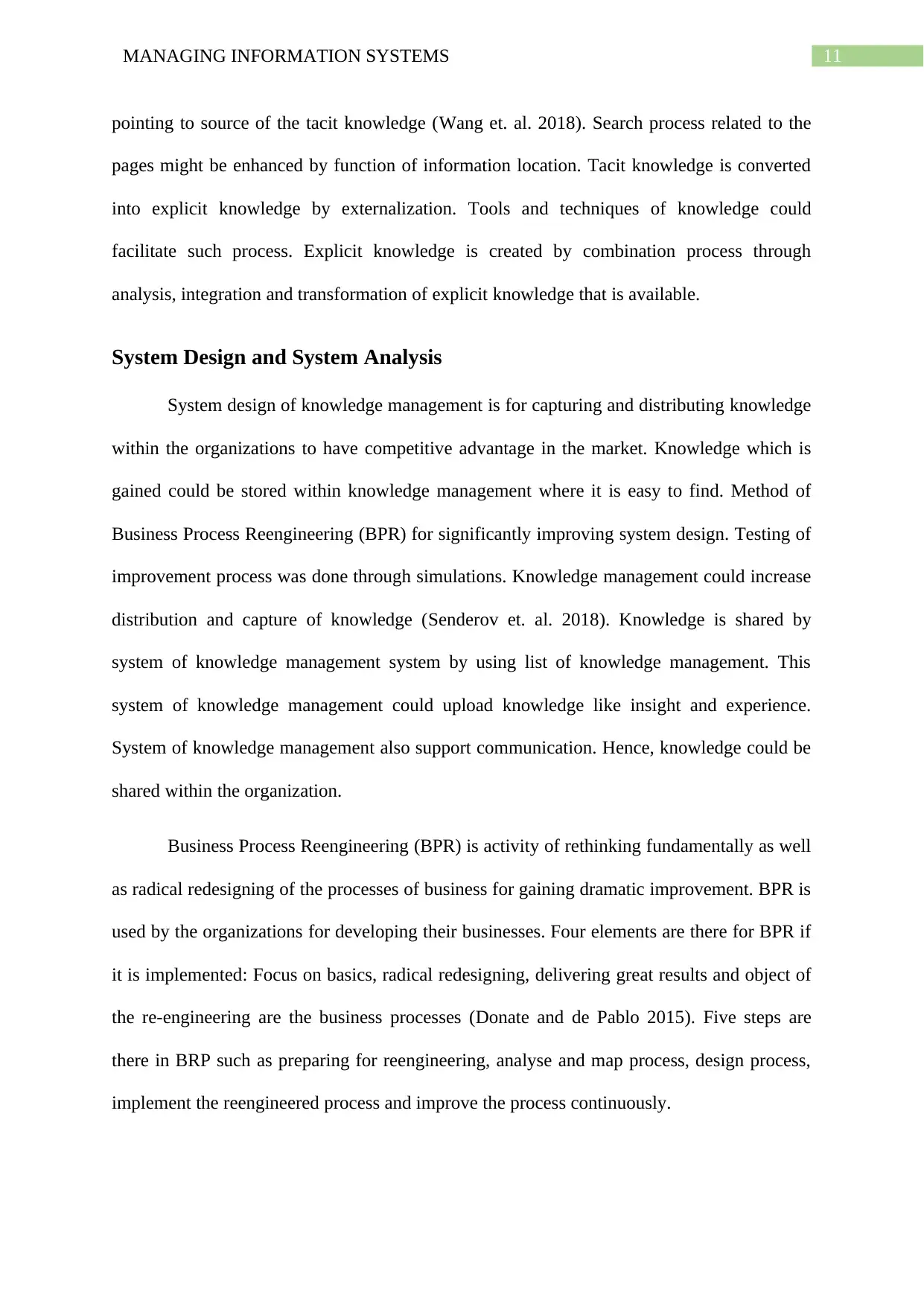
11MANAGING INFORMATION SYSTEMS
pointing to source of the tacit knowledge (Wang et. al. 2018). Search process related to the
pages might be enhanced by function of information location. Tacit knowledge is converted
into explicit knowledge by externalization. Tools and techniques of knowledge could
facilitate such process. Explicit knowledge is created by combination process through
analysis, integration and transformation of explicit knowledge that is available.
System Design and System Analysis
System design of knowledge management is for capturing and distributing knowledge
within the organizations to have competitive advantage in the market. Knowledge which is
gained could be stored within knowledge management where it is easy to find. Method of
Business Process Reengineering (BPR) for significantly improving system design. Testing of
improvement process was done through simulations. Knowledge management could increase
distribution and capture of knowledge (Senderov et. al. 2018). Knowledge is shared by
system of knowledge management system by using list of knowledge management. This
system of knowledge management could upload knowledge like insight and experience.
System of knowledge management also support communication. Hence, knowledge could be
shared within the organization.
Business Process Reengineering (BPR) is activity of rethinking fundamentally as well
as radical redesigning of the processes of business for gaining dramatic improvement. BPR is
used by the organizations for developing their businesses. Four elements are there for BPR if
it is implemented: Focus on basics, radical redesigning, delivering great results and object of
the re-engineering are the business processes (Donate and de Pablo 2015). Five steps are
there in BRP such as preparing for reengineering, analyse and map process, design process,
implement the reengineered process and improve the process continuously.
pointing to source of the tacit knowledge (Wang et. al. 2018). Search process related to the
pages might be enhanced by function of information location. Tacit knowledge is converted
into explicit knowledge by externalization. Tools and techniques of knowledge could
facilitate such process. Explicit knowledge is created by combination process through
analysis, integration and transformation of explicit knowledge that is available.
System Design and System Analysis
System design of knowledge management is for capturing and distributing knowledge
within the organizations to have competitive advantage in the market. Knowledge which is
gained could be stored within knowledge management where it is easy to find. Method of
Business Process Reengineering (BPR) for significantly improving system design. Testing of
improvement process was done through simulations. Knowledge management could increase
distribution and capture of knowledge (Senderov et. al. 2018). Knowledge is shared by
system of knowledge management system by using list of knowledge management. This
system of knowledge management could upload knowledge like insight and experience.
System of knowledge management also support communication. Hence, knowledge could be
shared within the organization.
Business Process Reengineering (BPR) is activity of rethinking fundamentally as well
as radical redesigning of the processes of business for gaining dramatic improvement. BPR is
used by the organizations for developing their businesses. Four elements are there for BPR if
it is implemented: Focus on basics, radical redesigning, delivering great results and object of
the re-engineering are the business processes (Donate and de Pablo 2015). Five steps are
there in BRP such as preparing for reengineering, analyse and map process, design process,
implement the reengineered process and improve the process continuously.
⊘ This is a preview!⊘
Do you want full access?
Subscribe today to unlock all pages.

Trusted by 1+ million students worldwide
1 out of 21
Related Documents
Your All-in-One AI-Powered Toolkit for Academic Success.
+13062052269
info@desklib.com
Available 24*7 on WhatsApp / Email
![[object Object]](/_next/static/media/star-bottom.7253800d.svg)
Unlock your academic potential
Copyright © 2020–2025 A2Z Services. All Rights Reserved. Developed and managed by ZUCOL.





